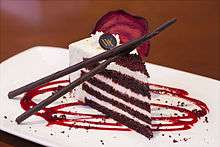Red velvet cake
 Four-layer slice of red velvet cake | |
| Type | Layer cake |
|---|---|
| Place of origin | United States |
| Region or state | Southern |
| Main ingredients | Flour, butter, sugar, buttermilk, cocoa powder, or cream cheese icing, beetroot or red food coloring |
|
| |
Red Velvet cake is similar to chocolate cake with either a red, bright red or red-brown color. While it is similar to chocolate cake, a baking aficionado will be able to spot the difference. The primary differences are in the use of buttermilk instead of milk and less cocoa powder. The acids in buttermilk react with the antacid of baking soda to form gas bubbles, which creates a non-yeast leavening. This helps create the fluffy and moist texture that has made Red Velvet popular. Red Velvet cake is traditionally prepared as a layer cake topped with cream cheese or cooked roux icing. It is popularly served on Christmas or Valentine's Day.[1]
Common ingredients include buttermilk, butter, cocoa, and flour for the cake, beetroot or red food coloring for the color.
History
James Beard's reference, American Cookery (1972),[2] describes three red velvet cakes varying in the amounts of shortening, butter, and vegetable oil. All used red food coloring, but the reaction of acidic vinegar and buttermilk tends to better reveal the red anthocyanin in cocoa and keeps the cake moist, light, and fluffy. This natural tinting may have been the source for the name "red velvet", as well as "Devil's food" and similar names for chocolate cakes.[3][4] Contemporarily, chocolate has often undergone Dutch processing, which prevents the color change of the anthocyanins.[5]
When foods were rationed during World War II, bakers used boiled beet juices to enhance the color of their cakes. Beets are found in some red velvet cake recipes, where they also serve to retain moisture. Adams Extract, a Texas company, is credited with bringing the red velvet cake to kitchens across America during the Great Depression era, by being one of the first to sell red food coloring and other flavor extracts with the use of point-of-sale posters and tear-off recipe cards.[6][7] The cake and its original recipe are well known in the United States from New York City's famous Waldorf-Astoria Hotel, which has dubbed the confection Waldorf-Astoria cake. However, it is widely considered a Southern recipe.[4] Traditionally, red velvet cake is iced with a French-style butter roux icing (also called ermine icing), which is very light and fluffy, but time-consuming to prepare. Cream cheese frosting and buttercream frosting are variations which have increased in popularity.[8][9]
In Canada, the cake was a well-known dessert in the restaurants and bakeries of the Eaton's department store chain, in the 1940s and 1950s. Promoted as an exclusive Eaton's recipe, with employees who knew the recipe sworn to silence, many mistakenly believed the cake was the invention of the department store matriarch, Lady Eaton.[10]
In recent years, red velvet cake and red velvet cupcakes have become increasingly popular in the US and many European countries. A resurgence in the popularity of this cake is attributed by some to the film Steel Magnolias (1989), which included a red velvet groom's cake made in the shape of an armadillo.[4] Magnolia Bakery in Manhattan, having served it since its opening in 1996, certainly helped to popularize the cake, as did restaurants known for their Southern cooking like Amy Ruth's in Harlem,[4] which opened in 1998.[11] In 2000,[12] Cake Man Raven opened one of the first bakeries devoted to the cake in Brooklyn.
References
| Wikimedia Commons has media related to Red velvet cakes. |
- ↑ "The rediscovery of red velvet has gone way too far". Quartz. 2015. Retrieved December 4, 2016.
- ↑ Beard, James (1972). James Beard's American Cookery. Boston: Little, Brown.
- ↑ Scott, Suzanne (June 7, 2003). "It's All Mixed Up! The History and True Facts About Baking Devil's Food Cake". New Jersey Baker's Board of Trade. Archived from the original on 2004-08-05. Retrieved 2004-10-10.
- 1 2 3 4 Fabricant, Florence (14 February 2007). "So Naughty, So Nice". The New York Times. Retrieved 22 August 2012.
- ↑ "Red Velvet Cake". The Big Bake Theory. Retrieved 2016-01-02.
- ↑ Parks, Stella (2011-10-02). "The Unknown History of Red Velvet Cake". Gilttaste.com.
- ↑ "Red Velvet, the 'Lady Gaga' of cakes, wears well during the holidays". Post-gazette.com. 2011-12-15. Retrieved 2012-11-08.
- ↑ Martha Stewart. "Cream Cheese Frosting for Red Velvet Cake". Retrieved 7 July 2016.
- ↑ Kim Severson. "Red Velvet Cake: A Classic, Not a Gimmick". Retrieved 7 July 2016.
- ↑ Anderson, Carol; Katharine Mallinson (2004). Lunch with Lady Eaton: Inside the Dining Rooms of a Nation. Toronto: ECW Press. ISBN 1-55022-650-9.
- ↑ "Amy Ruth's Home-Style Southern Cuisine". New York magazine. Retrieved March 27, 2014.
- ↑ "Cake Man Raven has flown the coop — no more red velvet cake in Fort Greene". NY Daily News. Nov 28, 2012.
